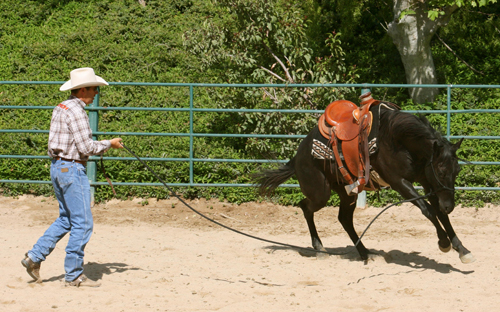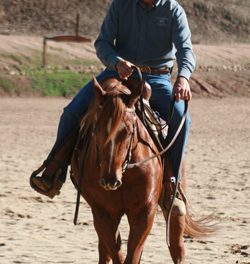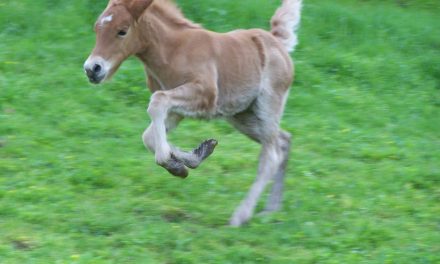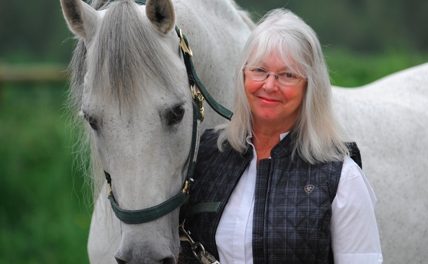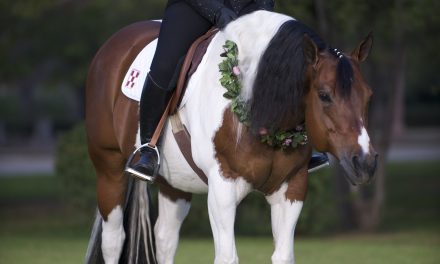PERFORMANCE HORSEMANSHIP WITH RICHARD WINTERS
I train horses and conduct horsemanship clinics for a living. My job requires that I ride numerous horses on any given day. By this time in my career, I suppose I have ridden thousands of horses. These horses have ranged from un-started colts to backyard pleasure horses to the finished bridle horse. I’ve been bucked off on occasion and have been in a few wrecks. Yet considering how many horses I’ve ridden, my serious mishaps have been few. Many articles have been written on how to avoid an “unplanned dismount.” However, the foundational safeguard for me is that I always have my horses go through the “full range of motion.”
Horses were created to walk, trot, lope, gallop, stop, turn, and then go some more! Yet the timid rider attempts to over control their horse. In essence, they are constantly riding the brakes. They’re afraid that the horse might get too volatile if they allow him to move out. The truth is that the bad energy can still be there, just under the surface. Then, at the most unexpected time, that energy comes out in the form of a buck, spook, or a run-away horse.
How do I minimize these negative reactions? If I have questions about how a horse is going to move out when ridden, I’m going to check things out on the ground before I ever climb on the horse’s back. Once the horse is saddled, I want to see the horse move through the full range of motion. I might do this on the end of a long lead rope or I could work the horse at liberty in a round pen. I want to see this saddled horse walk, trot, lope, turn and move off in both directions. I’m observing how efficiently the horse moves throughout the transitions. In other words, if it takes 25 pounds of energy to move through this full range of motion and the horse is putting 40 pounds of energy into it, he’s probably not ready for me to mount.
A naïve rider may think that fifteen minutes of trotting with a lunge line is an adequate warm-up, and it might be. Yet without seeing the horse transition into the lope a few times, the rider might not know the whole story. The saddle feels different at the lope than it does at the trot. It will feel different when a horse turns and pushes off with impulsion into a new direction as well. If you don’t check these things out prior to mounting, you might be getting on your horse prematurely.
I recently heard a world class colt starter answer the following question, “What do you do when the colt you’re riding starts to buck.” He responded, “I generally try to take care of that before I get on.” Part of this preparation is moving the horse through the full range of motion prior to mounting.
Another aspect to this concept is how you ride your horse. Many riders lack confidence and thus want their horse to move slowly and predictably down the trail or along the arena fence. Some horses will do that; most will not. Remember, they are horses, not golf carts. If you continually ride your horse on “safety” and never allow them to really move out in a productive manner, they will probably move out at some unexpected moment; resulting in an undesirable consequence.
“I just wanted to go out for a nice trail ride. Everything was fine. And then, all of a sudden, he just blew up!” I’ve heard this story line on numerous occasions. In most instances these riders failed to prepare the horse mentally and physically for their “quiet trail ride.” Did you move the horse through the full range of motion, with ground work, before mounting? Was he transitioning through these gaits relaxed and efficient? When mounted, did you give your horse some physical work to do prior to introducing the idea of a “quiet trail ride?” These are things that you must consider if you’re going to be your horse’s leader, resulting in both of you surviving the experience.
If you do not have the experience or confidence to ride your horse in an assertive manner, then perhaps it’s time to find help. Your horse needs a rider that will confidently lead and support him through the full range of motion.
It is not even in my horses paradigm to be ridden and not be loped consistently in both directions, every time. Invariably I will ride a participants “sticky” horse, during a clinic, and after loping around for a few minutes each way I will state the following: “I am guessing that I’ve just loped this horse more in the last ten minutes than his owner has loped him in the last six months.” Nine times out of ten the owner will concur. They’ll go on to say, “If he would lope around quiet and relaxed, I would lope him more.” Of course we know that he’ll never lope around quiet and relaxed until we lope him more. Yet people are scared to do it. Quite frankly, I’m too scared not to do it! There is too much that can build up underneath the surface that might pop up and bite me.
Horses were created to move. That’s their nature. It’s our job to channel their energy in a productive manner. Make sure your horse is comfortable, confident, and relaxed as he moves through the full range of motion.

